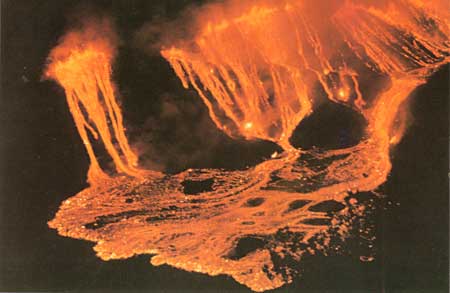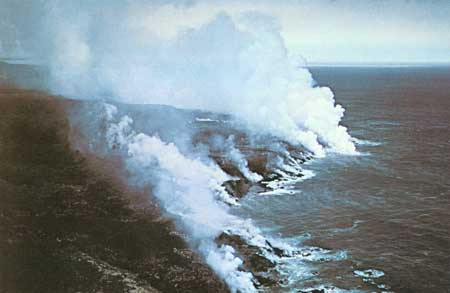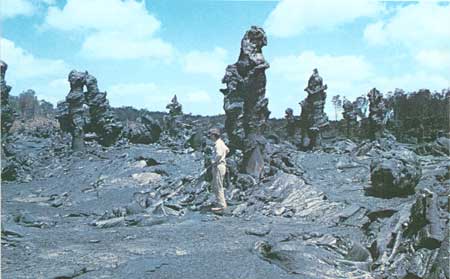|
HAWAI'I VOLCANOES & HALEAKALA Volcanoes of the National Parks of Hawaii |

|
KILAUEA, HOME OF PELE, THE FIRE GODDESS
(continued)
Activity from 1924 to 1951. The collapse that brought about the steam explosions of 1924 marked the end of the long-continued lava lake activity in Halemaumau. At the end of the collapse the crater was 1,300 feet deep. Molten lava reappeared in the bottom of the crater in July 1924, but the eruption lasted only a few days. Six more short eruptions took place between then and the autumn of 1934, filling the crater until the nearly flat lava floor was only 760 feet below the overlook at the crater's rim. The dates of the eruptions and approximate volumes of lava liberated are shown in Table 3.

FIGURE 5. Graph showing activity of Kilauea and Mauna Loa
volcanoes. The large amount of activity at Kilauea is very largely the
result of the Halemaumau lava lake. (Modified after Stearns and
Macdonald, 1946).
In 1934 began a period of almost 18 years during which there were no eruptions of Kilauea, though magma movement continued beneath the surface. Earthquakes and swelling of the volcano in 1944 indicated magma rising beneath it and an attempt at eruption. Again in 1950, outward tilting of the ground surface around Kilauea caldera indicated a swelling of the mountain caused by an increase of magmatic pressure beneath. In December 1950, this pressure was suddenly relieved, possibly by intrusion of lava into cracks in the rift zones of the volcano. The decrease of pressure resulted in a sinking of the entire mountain top, accompanied by hundreds of earthquakes (Figure 9). The central part of the caldera floor sank more than a foot in relation to the caldera rim.

PLATE 13. Cascades of lava pouring 300 feet down the crater
wall during the early stages of the Kilauea Iki eruption, 1959. NPS
photo by W. W. Dunmire
The eruption of 1952. The long period of quiet was terminated on the night of June 27, 1952, by an eruption in Halemaumau. A fissure opened across the crater floor, and for the next few hours a continuous line of lava fountains, half a mile long, spurted from it. Most of the fountains were 50 to 130 feet high, but at the southwest edge one more than 800 feet high overtopped the rifts of the crater. The southwestern part of the caldera floor and adjacent areas were blanketed with pumice. Very fluid lava, pouring out at a rate of 2,000,000 cubic yards per hour, quickly covered the entire crater floor, and by 4 o'clock the next morning the pool of liquid lava was 50 feet deep. A dark crust formed quickly on the lava, but was riven by a network of cracks that revealed the bright golden glow of the liquid beneath. Long waves, resembling ground swell on the ocean, rolled across the surface of the pool to dash 10 feet up the crater wall.
Activity continued, waxing and waning, but in general decreasing, until early November. At the southwestern edge of the crater a spectacular fountain continued for about a week, at times reaching a height of 600 feet; but at other times it died out completely and was replaced by a sink-hole where the liquid lava of the lake drained back into the conduit beneath. The crater floor rose slowly, partly because of repeated flooding of its surface by liquid lava, but partly by bodily elevation caused by forcing new lava beneath the solidified floor. By the time the eruption ended, on November 10, the depth of Halemaumau had been reduced from 770 to 460 feet.

PLATE 15. Lava entering the sea. This flow, during the 1960
Kapoho eruption, added nearly 500 acres of new land to the island of
Hawaii. NPS photo by R. Haugen
The eruptions of 1954 and 1955. At 4:30 on the morning of May 31, 1954, a fissure again opened across the floor of Halemaumau, and shortly afterward it extended northeastward across the caldera floor toward Kilauea Iki (Figure 4). A line of lava fountains, one of them 600 feet high, played on the crater floor, and a spectacular 300-foot cascade of golden-yellow lava poured from the fissure on the northeast wall of the crater. Fountains along the fissure northeast of Halemaumau built a row of small spatter cones, and a flow of pahoehoe quickly spread over an area of 139 acres. By mid-morning the pool of lava in Halemaumau was 63 feet deep, but about noon lava started draining back into the underlying conduit, reducing the final thickness of the new lava fill to 31 feet. The eruption was essentially over in less than 8 hours, though weak spattering continued until June 3.
Earthquakes commenced on the east rift zone of Kilauea in late January 1955. In late February they became very numerous, and on February 28 the volcano erupted. The first outbreak was about 25 miles east of Kilauea caldera. During the next 4 days new points of outbreak gradually extended 3 miles farther east, to the outskirts of Kapoho Village, and lava flows spread seaward. A lava fountain near Puu Kii, on the Pahoa-Kapoho road, reached a height of more than 800 feet. On March 6 activity abruptly ceased, but a new series of earthquakes indicated that the eruption was not over. On March 12 a new outbreak occurred, 2 miles southwest of the first outbreak point. Thence a new series of outbreaks over the next 2 weeks gradually spread 4 miles farther westward, sending 3 lava flows into the ocean.
For the first time in history the entire sequence of formation of new volcanic vents was studied by scientists at close range. First a barely-visible crack opened in the ground, then gas started to rise from the widening crack with gradually increasing pressure, then a bulb of red-hot lava a few inches across pushed out, gradually expanding, gas started to burst through it, and a lava fountain and flow were formed.
The eruption continued until May 26.

PLATE 16. Lava tree molds created by the March 1965 eruption
of Kilauea. USGS photo by Dallas Peck